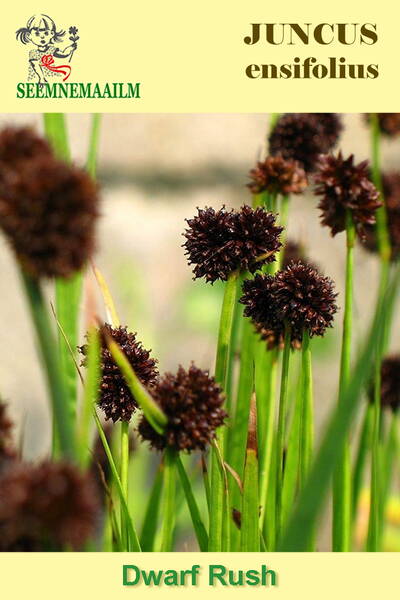Your shopping cart is empty!
Swordleaf rush "Starhead" (Flying Hedgehogs) (Juncus ensifolius)
Dwarf sword-leaved rush "Flying Hedgehogs" ("Starhead") - Juncus ensifolius.
Juncus ensifolius is an ornamental grass plant from the Juncaceae family. In the wild, it grows in damp, marshy places and shallow water.
Origin: North America, Japan, and Russia.
This variety is the most interesting and decorative species – its stems resemble iris leaves. The flat leaves are up to 5 mm wide, crowded at the base, and cover the stem. At the top of the stem are several dense, round, dark-brown inflorescences up to 1 cm in diameter. The plant height is 25-30 cm.
Blooms from June to August. After autumn frosts, the leaves begin to dry out, but the inflorescences retain their charm for a long time.
The plant is very undemanding. Grows in both sun and partial shade. It's perfect for landscaping ponds in a natural style, as well as bog garden compositions. It contrasts beautifully with broadleaf aquatic plants and floating water lily leaves.
The plant is non-invasive and maintains its strict geometric shape for several years, remaining within its designated range.
It overwinters without shelter, withstanding temperatures down to -35°C (hardiness zones: Z3 - Z10).
Cultivation.
Sow seeds in April on the soil surface for pre-germination. Press the seeds into the soil, cover, and cover with glass or film. Mist and aerate the crops daily. At temperatures of +20°C, the seeds germinate within a week. It's a wonderful accent plant for flower beds and various garden containers, but its moisture-loving nature should be taken into account. In spring, old leaves are cut from the turf at a height of 3-5 cm. When growing in containers, it is recommended to provide the plant with a temperature of no higher than +10°C during the winter.
1,0 g = 71000 seeds.
Juncus ensifolius is an ornamental grass plant from the Juncaceae family. In the wild, it grows in damp, marshy places and shallow water.
Origin: North America, Japan, and Russia.
This variety is the most interesting and decorative species – its stems resemble iris leaves. The flat leaves are up to 5 mm wide, crowded at the base, and cover the stem. At the top of the stem are several dense, round, dark-brown inflorescences up to 1 cm in diameter. The plant height is 25-30 cm.
Blooms from June to August. After autumn frosts, the leaves begin to dry out, but the inflorescences retain their charm for a long time.
The plant is very undemanding. Grows in both sun and partial shade. It's perfect for landscaping ponds in a natural style, as well as bog garden compositions. It contrasts beautifully with broadleaf aquatic plants and floating water lily leaves.
The plant is non-invasive and maintains its strict geometric shape for several years, remaining within its designated range.
It overwinters without shelter, withstanding temperatures down to -35°C (hardiness zones: Z3 - Z10).
Cultivation.
Sow seeds in April on the soil surface for pre-germination. Press the seeds into the soil, cover, and cover with glass or film. Mist and aerate the crops daily. At temperatures of +20°C, the seeds germinate within a week. It's a wonderful accent plant for flower beds and various garden containers, but its moisture-loving nature should be taken into account. In spring, old leaves are cut from the turf at a height of 3-5 cm. When growing in containers, it is recommended to provide the plant with a temperature of no higher than +10°C during the winter.
1,0 g = 71000 seeds.












